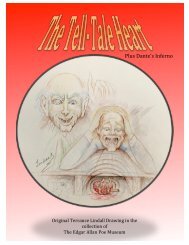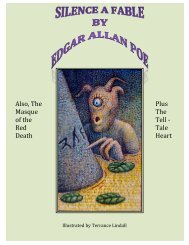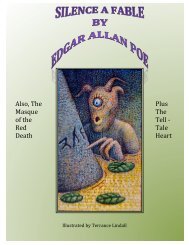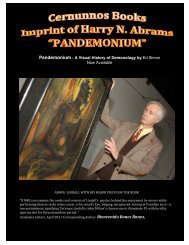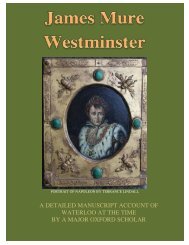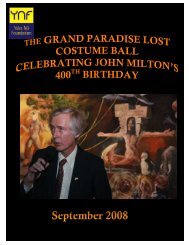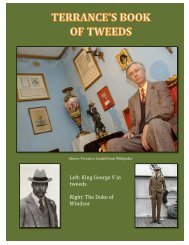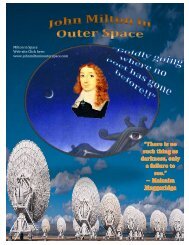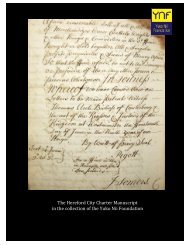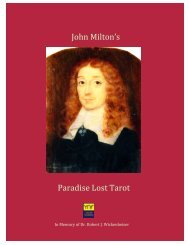Last Will and Testament of Dowager Lady Strathmore
The last will of testament of Dowager Lady Strathmore, the soliiciter’s copy, hand written and executed at the same time as the original with original signatures. The WAH Center houses the last will of testament of Dowager Lady Strathmore, including her marriage contract and the entire inventory of Glamis Castle. The Lady Strathmore was the mother to the Queen Mother of England who died recently at the age of 101 years in 2002 AD. She was one of the most beloved of the British monarchs. During the Second World War, when the Nazi’s were bombing London, she refused to move to the safety of the countryside. preferring to remain “with her people.” The Earl of Strathmore and his wife lived in Glamis castle. One of most legended castles in the world, it is “ a soaring pile of keep and towers, turrets and battlements.” It is said to have more dark secrets than any castle in Britain. And it has numerous ghosts. The gentlest ghost and most often seen is the "Grey Lady." She appears in the chapel. Few families are older than the Bowes-Lyons, The Lady and Earl of Strathmore. They had their own army 600 years ago and their own private hangman. King Malcolm II of Scotland was murdered here. Shakespeare placed the murder of Duncan by Macbeth in the stone floored vaulted Duncan’s hall of the castle. And when the Queen mother was a child, she and her sisters always scuttled at top speed through this room.
The last will of testament of Dowager Lady Strathmore, the soliiciter’s copy, hand written and executed at the same time as the original with original signatures.
The WAH Center houses the last will of testament of Dowager Lady Strathmore, including her marriage contract and the entire inventory of Glamis Castle. The Lady Strathmore was the mother to the Queen Mother of England who died recently at the age of 101 years in 2002 AD. She was one of the most beloved of the British monarchs. During the Second World War, when the Nazi’s were bombing London, she refused to move to the safety of the countryside. preferring to remain “with her people.” The Earl of Strathmore and his wife lived in Glamis castle. One of most legended castles in the world, it is “ a soaring pile of keep and towers, turrets and battlements.” It is said to have more dark secrets than any castle in Britain. And it has numerous ghosts. The gentlest ghost and most often seen is the "Grey Lady." She appears in the chapel.
Few families are older than the Bowes-Lyons, The Lady and Earl of Strathmore. They had their own army 600 years ago and their own private hangman. King Malcolm II of Scotland was murdered here. Shakespeare placed the murder of Duncan by Macbeth in the stone floored vaulted Duncan’s hall of the castle. And when the Queen mother was a child, she and her sisters always scuttled at top speed through this room.
You also want an ePaper? Increase the reach of your titles
YUMPU automatically turns print PDFs into web optimized ePapers that Google loves.
The <strong>Last</strong> <strong>Will</strong> <strong>and</strong> <strong>Testament</strong> <strong>of</strong><br />
Frances Dora Bowes-Lyon,<br />
Countess <strong>of</strong> <strong>Strathmore</strong> <strong>and</strong> Kinghorne<br />
<br />
119
Frances Dora Bowes-Lyon, Countess <strong>of</strong> <strong>Strathmore</strong> <strong>and</strong><br />
Kinghorne (née Smith; 29 July 1832 – 5 February 1922) was a British<br />
noblewoman. She was the paternal gr<strong>and</strong>mother <strong>of</strong> Queen Elizabeth<br />
The Queen Mother, <strong>and</strong> thus a great-gr<strong>and</strong>mother <strong>of</strong> Queen<br />
Elizabeth II.<br />
Her <strong>Last</strong> <strong>Will</strong> <strong>and</strong> <strong>Testament</strong><br />
Collection Yuko Nii Foundation<br />
By Terrance Lindall<br />
Information from various sources<br />
Copyright 2021 YNF<br />
<br />
120
the 13 th Earl <strong>and</strong> Countess <strong>of</strong> <strong>Strathmore</strong> <br />
<br />
121
The <strong>Will</strong>iamsburg Art & Historical Center contains many paper<br />
treasures. But from the British Isles there is one set <strong>of</strong> documents<br />
which has a compelling history:<br />
The last will <strong>of</strong> testament <strong>of</strong> <strong>Dowager</strong> <strong>Lady</strong> <strong>Strathmore</strong>, the<br />
soliiciter’s copy, h<strong>and</strong> written <strong>and</strong> executed at the same time as the<br />
original with original signatures.<br />
The WAH Center houses the last will <strong>of</strong> testament <strong>of</strong> <strong>Dowager</strong> <strong>Lady</strong><br />
<strong>Strathmore</strong>, including her marriage contract <strong>and</strong> the entire inventory<br />
<strong>of</strong> Glamis Castle. The <strong>Lady</strong> <strong>Strathmore</strong> was the mother to the Queen<br />
Mother <strong>of</strong> Engl<strong>and</strong> who died recently at the age <strong>of</strong> 101 years in 2002<br />
AD. She was one <strong>of</strong> the most beloved <strong>of</strong> the British monarchs.<br />
During the Second World War, when the Nazi’s were bombing<br />
London, she refused to move to the safety <strong>of</strong> the countryside.<br />
preferring to remain “with her people.” The Earl <strong>of</strong> <strong>Strathmore</strong> <strong>and</strong><br />
his wife lived in Glamis castle. One <strong>of</strong> most legended castles in the<br />
world, it is “ a soaring pile <strong>of</strong> keep <strong>and</strong> towers, turrets <strong>and</strong><br />
battlements.” It is said to have more dark secrets than any castle in<br />
Britain. And it has numerous ghosts. The gentlest ghost <strong>and</strong> most<br />
<strong>of</strong>ten seen is the "Grey <strong>Lady</strong>." She appears in the chapel.<br />
Few families are older than the Bowes-Lyons, The <strong>Lady</strong> <strong>and</strong> Earl <strong>of</strong><br />
<strong>Strathmore</strong>. They had their own army 600 years ago <strong>and</strong> their own<br />
private hangman. King Malcolm II <strong>of</strong> Scotl<strong>and</strong> was murdered here.<br />
Shakespeare placed the murder <strong>of</strong> Duncan by Macbeth in the stone<br />
floored vaulted Duncan’s hall <strong>of</strong> the castle. And when the Queen<br />
mother was a child, she <strong>and</strong> her sisters always scuttled at top speed<br />
through this room.<br />
<br />
Young Elizabeth at Glamis<br />
122
<strong>Lady</strong> Glamis (Janet Douglas)<br />
was burnt by James V as a witch <strong>and</strong> now<br />
haunts Glamis Castle as “The Grey <strong>Lady</strong>”<br />
<br />
123
The Grey <strong>Lady</strong> is not the only ghost to haunt its halls. The most<br />
appalling legend <strong>of</strong> all if <strong>of</strong> the toungeless woman, The late Sir<br />
David Bowes-Lyon is said to have seen her while taking a late stroll<br />
after dinner on the lawn. There he saw the girl gripping the window<br />
bars <strong>and</strong> staring distractedly in to the night. He was about to speak<br />
to her when she disappeared abruptly as if someone had torn her<br />
away from the window. There came one appalling scream – then<br />
utter silence. It as one minute to midnight. The Toungueless <strong>Lady</strong> is<br />
said to be a vampire whom the lords had punished savagely. Since<br />
vampires do not die, it is a pretty thought that she lies entombed in<br />
the castle, her eyes closed, her teeth sharp, her menace still potent.<br />
<br />
Toungeless <strong>Lady</strong> <strong>of</strong> Glamis<br />
by Biemvenido Bones Banez<br />
124
I was in touch with the Glamis Castle Librarian. She was very nice:<br />
Dear Terrance,<br />
Thank you for your e-‐mail. You may be interested in the enclosed <br />
extract from The Rev. John Stirton’s book ‘Glamis A Parish History’ <br />
(Forfar, W. Shepherd, 1913) on the 13 th Earl <strong>and</strong> Countess <strong>of</strong> <br />
<strong>Strathmore</strong>, as well as the enclosed photograph <strong>of</strong> the couple on the <br />
occasion <strong>of</strong> their Golden Wedding in 1903. We also hold the diaries <strong>of</strong> <br />
Claude, 13 th Earl, for 1844 <strong>and</strong> 1861 to 1904 at Glamis. The peerage <br />
web site is helpful if you are trying to piece together the Bowes Lyon <br />
family history; for Claude, 13 th Earl, see <br />
http://www.thepeerage.com/p10083.htm#i100829<br />
Thank you again for passing on the scanned copies. It is amazing what <br />
can get buried in lawyers’ <strong>of</strong>fices; their records can be a veritable <br />
treasure trove. I have listed a few lawyers’ collections over the years <br />
<strong>and</strong> they tend to cover a diverse (<strong>and</strong> sometimes surprising!) subject <br />
area. Please do not hesitate to contact me if you have any other <br />
queries <strong>and</strong> you are most welcome to visit Glamis in the future.<br />
With best wishes,<br />
Ingrid<br />
<br />
125
No family has had a more intriguing past. A lady Glamis was burnt by<br />
James V as a witch, yet a few years alter, Mary, Queen <strong>of</strong> Scots dined<br />
with the family <strong>and</strong> stayed the night. A monster is said to have dwelt<br />
in Loch Calder near the castle. There are many bricked up rooms in<br />
the castle. Somewhere in the sixteen-foot thick walls is the famous<br />
room <strong>of</strong> skulls, where the Ogilvies family, who sought protection<br />
from their enemies the Lindsay’s, were walled up to die <strong>of</strong> starvation,<br />
being no friends <strong>of</strong> the <strong>Strathmore</strong>s. The tradition <strong>of</strong> the heavy pile<br />
contain much by its appearance <strong>and</strong> is impressive to the imagination.<br />
An 1845 illustration by R. R.<br />
McIan, from James<br />
Logan's The Clans <strong>of</strong> the<br />
Scottish Highl<strong>and</strong>s showing the<br />
Ogilvie tartan<br />
<br />
126
I also inquired to the National Archives:<br />
Dear Mr Lindall,<br />
Thank you for your email <strong>of</strong> 1 November 2013.<br />
I'm afraid I'm not quite sure what you're asking about. The<br />
picture <strong>of</strong> the bundle <strong>of</strong> papers tied with a ribbon is too small for<br />
me to see what is typed on the top one. The other picture<br />
shows the Inventory <strong>of</strong> Claude Bowes Lyon, Earl <strong>of</strong> <strong>Strathmore</strong>,<br />
from 1904.<br />
We hold the <strong>of</strong>ficial record <strong>of</strong> the latter under ref SC47/40/72,<br />
pp175-179. We also hold similar for Marianne, <strong>Dowager</strong><br />
Countess <strong>of</strong> <strong>Strathmore</strong>, recorded in 1850, SC70/1/70, pp231-<br />
233.<br />
It is not impossible that the family <strong>and</strong>/or their lawyers kept<br />
copies <strong>of</strong> this information, although I don't quite know how it<br />
would have ended up in <strong>Will</strong>iamsburg! However, I can assure<br />
you that we have the records we should have, <strong>and</strong> that the ones<br />
you hold are not part <strong>of</strong> the <strong>of</strong>ficial records <strong>of</strong> wills <strong>and</strong><br />
inventories in Scotl<strong>and</strong>.<br />
Yours sincerely,<br />
Alison Lindsay | Head <strong>of</strong> Historical <strong>and</strong> Legal Search Rooms<br />
National Records <strong>of</strong> Scotl<strong>and</strong> | General Register House | Edinburgh EH1 3YY<br />
<br />
127
The Haunted Homes <strong>and</strong> Family Traditions <strong>of</strong> Great Britain, pp. 462 - 465,<br />
by John Henry Ingram published 1897<br />
"It happened once, on a dark <strong>and</strong> stormy November night, that Earl <br />
Patie had been wearied by his forced inactivity from horse <strong>and</strong> <br />
hound — for it was the Lord's Day, <strong>and</strong> that means complete <br />
abstinence from all worldly pursuits in bonnie Scotl<strong>and</strong> — <strong>and</strong>, at <br />
last, with oaths <strong>and</strong> curses, he called for a pack <strong>of</strong> cards, <strong>and</strong> <br />
comforted himself with the anticipation <strong>of</strong> a pleasant game. The <br />
ladies were at their devotions, so he called the servants to him, one <br />
by one; but never since the days <strong>of</strong> the feast in the New <strong>Testament</strong> <br />
were so many excuses invented to cover disinclination. Of all those <br />
who had humoured him so <strong>of</strong>ten, not one could be found, from the <br />
steward to the scullion, to take a h<strong>and</strong> with the wicked Earl. In <br />
desperation the chaplain was attacked; but he, too, proved <br />
temptation pro<strong>of</strong>, <strong>and</strong> strengthened the rebellion among the <br />
menials by br<strong>and</strong>ing the pack <strong>of</strong> cards as 'devil's bricks,' <strong>and</strong> <br />
hurling terrible anathemas at the head <strong>of</strong> any wight who should <br />
venture on so terrible a desecration <strong>of</strong> the Sabbath. For a time <br />
there was dire confusion <strong>and</strong> alarm in the Castle; <strong>and</strong> at last Earl <br />
Patie, swearing tremendously, <strong>and</strong> consigning everybody around <br />
him to an unmentionable locality, seized a pack <strong>of</strong> cards <strong>and</strong> went <br />
growling away up the old oak stairs to his chamber, saying he <br />
would play with the 'devil himself,' sooner than be thwarted in his <br />
desire. <br />
<br />
Self Portrait Terrance Lindall, 1964<br />
128
"He had not sat long in the room before a knock came at the door, <strong>and</strong> a<br />
deep voice sounded from the corridor, asking the Earl if he wished a<br />
partner. 'Yes,' roared the Earl; 'enter, in the foul fiend's name, whoever<br />
you are.' And with that there entered a tall, dark stranger, wholly<br />
wrapped up in a cloak, who nodded in a familiar manner to the Earl, <strong>and</strong><br />
took his seat on a vacant chair on the opposite side <strong>of</strong> the table. The Earl<br />
stared at his strange guest, <strong>and</strong> doubtless felt a momentary uneasiness as<br />
he remembered whom he had invited to play with him; but a look at the<br />
cards on the table reassured him, <strong>and</strong> they commenced the game in real<br />
earnest. The stranger, who did not remove his bonnet <strong>and</strong> cloak,<br />
proposed a high stake; <strong>and</strong> in reply the Earl said, if he were the loser,<br />
<strong>and</strong> had not wherewith to discharge his debt, he would sign a bond for<br />
whatever his guest might choose to ask. Fast <strong>and</strong> furious became the<br />
game, loud oaths resounded through the chamber, <strong>and</strong> the terrified<br />
menials crept up the corridor, wondering what brave man dared to b<strong>and</strong>y<br />
words with the wicked Earl, <strong>and</strong> who was sinful enough to hold his h<strong>and</strong><br />
at the 'devil's bricks' on the Lord's Day. As they fearfully listened they<br />
could hear the fierce utterances <strong>of</strong> the Earl, <strong>and</strong> the fiercer <strong>and</strong> more<br />
unearthly utterances <strong>of</strong> the stranger, whose presence they were quite<br />
unable to account for.<br />
<br />
129
"At last the old butler, who had served the family for two generations, <br />
ventured close to the chamber-‐door <strong>and</strong> peeped through the key-‐hole; <br />
but no sooner had he done so than he fell back <strong>and</strong> rolled on the floor <br />
with a yell <strong>of</strong> agony that resounded to the remotest part <strong>of</strong> the Castle. <br />
In an instant the door was rudely torn open <strong>and</strong> the Earl came out with <br />
fury in his face, <strong>and</strong> told them to slay anyone who passed, while he <br />
went back to settle with his guest. But his guest was nowhere to be <br />
found. They searched the chamber through <strong>and</strong> through, but in vain. <br />
He was gone, <strong>and</strong> he had taken with him Earl Patie's bond, but what <br />
for the confused <strong>and</strong> startled Earl did not exactly know. Returning by <br />
the old butler, Earl Patie found him stunned <strong>and</strong> bruised, with a yellow <br />
circle round the erring eye; <strong>and</strong> then he told the terror-‐stricken <br />
menials that, as he sat at play, the stranger suddenly threw down his <br />
cards <strong>and</strong> said, with an oath, 'Smite that eye!' whereupon a sheet <strong>of</strong> <br />
flame darted directly to the key-‐hole, <strong>and</strong> the mysterious stranger <br />
disappeared. <br />
"Earl Patie lived five years before he paid his bond, but afterwards, on <br />
every Sabbath evening, the old chamber was filled with strange noises <br />
that echoed through the passages, as if the wicked Earl <strong>and</strong> the dark <br />
stranger were again wrangling <strong>and</strong> swearing over the 'devil's bricks.' <br />
For a time the unearthly noises were put up with, but at last the room <br />
was built up, <strong>and</strong> nothing now remains to tell where the chamber was <br />
where Earl Patie <strong>and</strong> his fiery guest played their stormy game <strong>of</strong> <br />
cards." Such is the story, according to local tradition, <strong>of</strong> the secret <br />
room <strong>of</strong> Glamis Castle. <br />
<br />
130
131
132
From the National Portrait Gallery<br />
<br />
133
134
135
From “Royal Splendor”<br />
Queen Elizabeth II’s maternal gr<strong>and</strong>parents were the Earl <strong>and</strong> Countess <strong>of</strong><br />
<strong>Strathmore</strong>. They were the parents <strong>of</strong> Queen Elizabeth the Queen Mother,<br />
who was born in Scotl<strong>and</strong>. The <strong>Strathmore</strong>s could claim ancestry to the<br />
Scottish king Robert the Bruce <strong>and</strong> they were also Scotl<strong>and</strong>’s largest<br />
l<strong>and</strong>owners. They were a “sporting, military family, their politics were<br />
conservative <strong>and</strong> their style old-fashioned” family. It was customary<br />
among the wealthy those days to divide their time among their many<br />
homes <strong>and</strong> the <strong>Strathmore</strong>s were not short <strong>of</strong> houses. They had Glamis for<br />
an <strong>of</strong>ficial family seat, where late summers <strong>and</strong> early autumns were spent.<br />
The elegant Queen Anne mansion <strong>of</strong> St Paul’s Walden Bury in<br />
Hertforhshire would serve as their weekend retreat. This was also the<br />
home <strong>of</strong> Lord <strong>and</strong> <strong>Lady</strong> Glamis before Lord Glamis succeeded his father<br />
to the title. The social season meant that the family would decamp to<br />
London, where they owned a huge townhouse in St. James’ Square.<br />
<br />
136
From St. Paul’s Website:<br />
St Paul’s Walden Bury is a notable l<strong>and</strong>scape garden, laid out in the<br />
early 18th-century, covering about 50 acres.<br />
This is the childhood home <strong>of</strong> Queen Elizabeth the Queen Mother.<br />
Long avenues lead to temples, statues, lake <strong>and</strong> ponds. Flower<br />
gardens bloom in spring <strong>and</strong> summer, with beautiful displays <strong>of</strong><br />
magnolias, rhododendrons, irises, lilies. Wild flowers are encouraged,<br />
especially cowslips, bluebells, spotted orchids.<br />
The surrounding estate, with its arable <strong>and</strong> livestock farm <strong>and</strong> its<br />
ancient woodl<strong>and</strong>, is a traditional country estate set in the heart <strong>of</strong> the<br />
beautiful Hertfordshire countryside.<br />
The front <strong>of</strong> the house dates from 1720, notable for its charming<br />
architecture. There is also a substantial Victorian addition. Inside the<br />
beautiful Green Drawing Room <strong>and</strong> Red Drawing Room are decorated<br />
with very fine plasterwork.<br />
<br />
137
138
139
140
141
142
143
144
145
146
The 13 th Earl, Claude, had what is commonly known as an “edifice<br />
complex.” He liked to build <strong>and</strong> did much to improve the grounds <strong>of</strong><br />
Glamis Castle, much in the same way as Engl<strong>and</strong> was improving upon<br />
<strong>and</strong> exp<strong>and</strong>ing it’s Empire under Queen Victoria. He could afford lavish<br />
improvements to the Caste <strong>and</strong> grounds because <strong>of</strong> the financial<br />
holdings <strong>of</strong> the family brought to him in part when his predecessor, his<br />
older brother Thomas, who died in 1865. Among many holdings listed<br />
in the inventory copies owned by the Yuko Nii Foundation <strong>and</strong> dated<br />
1904 are: shares <strong>of</strong> the Royal bank <strong>of</strong> Scotl<strong>and</strong>, North British <strong>and</strong><br />
Mercantile Insurance Company, the Caledonian Railway Company, The<br />
Scottish Guardian Newspaper, <strong>and</strong> more. They owned various castles<br />
<strong>and</strong> other properties in Engl<strong>and</strong>, Scotl<strong>and</strong> <strong>and</strong> beyond, including<br />
Streatham Castle with various farming properties situated thereto.<br />
Essentially, the family’s investments exp<strong>and</strong>ed tremendously with the<br />
success <strong>of</strong> the British Empire, allowing them a very comfortable <strong>and</strong><br />
privileged position as one <strong>of</strong> the leading noble families <strong>of</strong> Great Britain.<br />
Biarritz where Claude died in 1904 became more renowned in 1854<br />
when Empress Eugenie (the wife <strong>of</strong> Napoleon III) built a palace on the<br />
beach (now the Hôtel du Palais). European royalty, including British<br />
monarchs Queen Victoria <strong>and</strong> King Edward VII (who caused a minor<br />
sc<strong>and</strong>al when he called H. H. Asquith to kiss h<strong>and</strong>s at Biarritz in 1908<br />
rather than return to London for the purpose),[1] <strong>and</strong> the Spanish king<br />
Alfonso XIII, were frequent visitors.<br />
Biarritz's casino (opened 10 August 1901) <strong>and</strong> beaches make the town a<br />
notable tourist centre for Europeans, <strong>and</strong> East Coast North Americans.<br />
The city has also become more recently a prime destination for surfers<br />
from around the world, developing a nightlife <strong>and</strong> surf based culture.<br />
<br />
147
The Episode <strong>of</strong> Claude, the 13 th Earl, <strong>and</strong> the “Mad Mr.<br />
Henegage”<br />
In 1885 a peculiar episode occurred when invitations were sent out for<br />
a ball at the Hotel Palais Biarritz. Mr. Charles Heneage, who had put<br />
down his cousin Miss Chalfont up for one <strong>of</strong> the invitations, became<br />
enraged when he found it was to be held at a casino. Claude had just<br />
sat down to a breakfast <strong>of</strong> rolls <strong>and</strong> c<strong>of</strong>fee at the Vila Bon Air when a<br />
letter was placed in front <strong>of</strong> him from this Mr. Heneage written earlier<br />
in the morning. Mr. Heneage was also <strong>of</strong> a respectable lineage from<br />
Hainton Hall in Lincolnshire. Mr. Heneage’s letter went on to accuse<br />
the earl <strong>of</strong> having invited Miss Chalfont to “a locality prior to that<br />
date used for immoral purposes.”<br />
Hotel Palais Biarritz<br />
<br />
148
In January 1886 Claude received another letter from Mr. Heneage<br />
saying <strong>of</strong> the location “ it is not suitable for this purpose since other<br />
vices beyond gambling have been permitted under public surveillance.,”<br />
<strong>and</strong> on <strong>and</strong> on Heneage rambled.<br />
A plethora <strong>of</strong> letters from Mr. Heneage went out to other members <strong>of</strong><br />
the aristocracy <strong>and</strong> government <strong>of</strong>ficials. Many <strong>of</strong> the letters were<br />
shown to or sent to Claude from persons <strong>of</strong>fended <strong>and</strong> dumbstruck by<br />
the tirades <strong>of</strong> “Mad” Mr. Heneage. Mr. Heneage’s own brother<br />
apologized for the behavior <strong>of</strong> Charles stating that there was nothing he<br />
could do to end the irrational behavior.<br />
Finally, fed up with the entire mess, Lord <strong>Strathmore</strong> took his revenge.<br />
He posted this in the drawing room <strong>of</strong> the Hotel l’Angleterre ( in his<br />
own h<strong>and</strong>writing) :<br />
One Mr Heneage, so they say,<br />
A dreadful row has made today,<br />
About the Ball committee.<br />
And very naughty words has used,<br />
And Palais Barritz much abused<br />
In Language which we pity.<br />
If Mr, Heneage be so pure;<br />
He’s much too good for us I’m sure,<br />
This Paragon <strong>of</strong> Virtue.<br />
So what could the Committee say,<br />
Except “You’d better stay away,<br />
For fear the place will hurt you!”<br />
1) Receipt from Ernestine Hester Maud Scott & Others<br />
<br />
149
150






